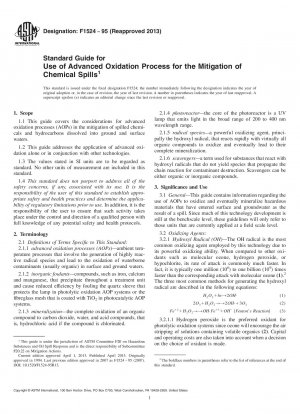ASTM F1524-95(2013)
Standard Guide for Use of Advanced Oxidation Process for the Mitigation of Chemical Spills
- Standard No.
- ASTM F1524-95(2013)
- Release Date
- 1995
- Published By
- American Society for Testing and Materials (ASTM)
- Status
- Replace By
- ASTM F1524-22
- Latest
- ASTM F1524-22
- Scope
3.1 General—This guide contains information regarding the use of AOPs to oxidize and eventually mineralize hazardous materials that have entered surface and groundwater as the result of a spill. Since much of this technology development is still at the benchscale level, these guidelines will only refer to those units that are currently applied at a field scale level.
3.2.1 Hydroxyl Radical (OH)—The OH radical is the most common oxidizing agent employed by this technology due to its powerful oxidizing ability. When compared to other oxidants such as molecular ozone, hydrogen peroxide, or hypochlorite, its rate of attack is commonly much faster. In fact, it is typically one million (106) to one billion (109) times faster than the corresponding attack with molecular ozone (1).2 The three most common methods for generating the hydroxyl radical are described in the following equations:



3.2.1.1 Hydrogen peroxide is the preferred oxidant for photolytic oxidation systems since ozone will encourage the air stripping of solutions containing volatile organics (2) . Capital and operating costs are also taken into account when a decision on the choice of oxidant is made.
3.2.2 Photolysis—Destruction pathways, besides the hydroxyl radical attack, are very important for the more refractory compounds such as chloroform, carbon tetrachloride, trichloroethane, and other chlorinated methane or ethane compounds. A photoreactor's ability to destroy these compounds photochemically will depend on its output level at specific wavelengths. Since most of these lamps are proprietary, preliminary benchscale testing becomes crucial when dealing with these compounds.
3.3.1 Advanced oxidation processes (AOPs) may be applied alone or in conjunction with other treatment techniques as follows:
ASTM F1524-95(2013) history
- 2022 ASTM F1524-22 Standard Guide for Use of Advanced Oxidation Process for the Mitigation of Chemical Spills
- 1995 ASTM F1524-95(2013) Standard Guide for Use of Advanced Oxidation Process for the Mitigation of Chemical Spills
- 1995 ASTM F1524-95(2007) Standard Guide for Use of Advanced Oxidation Process for the Mitigation of Chemical Spills
- 1995 ASTM F1524-95(2001) Standard Guide for Use of Advanced Oxidation Process for the Mitigation of Chemical Spills
- 1995 ASTM F1524-95 Standard Guide for Use of Advanced Oxidation Process for the Mitigation of Chemical Spills

Copyright ©2024 All Rights Reserved

